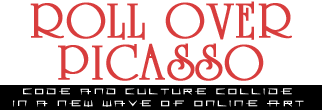|
|
Really immediate -- because even the most complex code is
easy to change. And unexpected change that might jostle the
establishment is what sets new artists apart. So on the eve of the
Biennial's opening, ®TMark became its own exhibit: When visitors
would link to the site through the Whitney, any number of other
sites, accepted by ®TMark and randomly displayed on its home page,
might appear in its stead. Such as the sneakily subversive ThisModernWorld.com.
In a sense, this "ha -- made you look" approach is precisely what
it's all about. The medium is fluid. It never stops changing. And
the change, instigated by the viewer or by the artist, is defining a
new art space.
So what does it mean? Perhaps we
are now getting a sense of our own transiency, and just as
built-to-last companies have been replaced by built-to-flip dot-coms
looking for a quick IPO, art has shifted away from providing icons
for the ages. As graffiti crews paint over the masterpieces of their
neighborhood competitors, or as weather and demolition take down the
latest writing on the wall, so too a single snippet of code or a
purposeful HTML tag will erase the latest cybercreation. It's not
about taking yourself seriously; it's about constant evolution.
Although connoisseurs of online art
won't be surprised at the choices in the Biennial, they may react to
a few omissions. Conspicuous in its absence is The Remedi Project, a
collaboration of Web artists widely accepted as having set the bar
for online design and experimentation. Also missing is the
award-winning Once Upon a
Forest, a cross between a Net hallucination and an interactive
calendar.
As more curators come to appreciate the workings of the pixel
palette, this coterie of artists will spring from the subculture
into our computers, not only decorating our desktops but also
redefining the limits of the technological horizon. Ultimately, they
may challenge our own ability to reinvent ourselves.
Rebecca
Paoletti is editor in chief of Road Runner and former
editor of SOMA.
|




